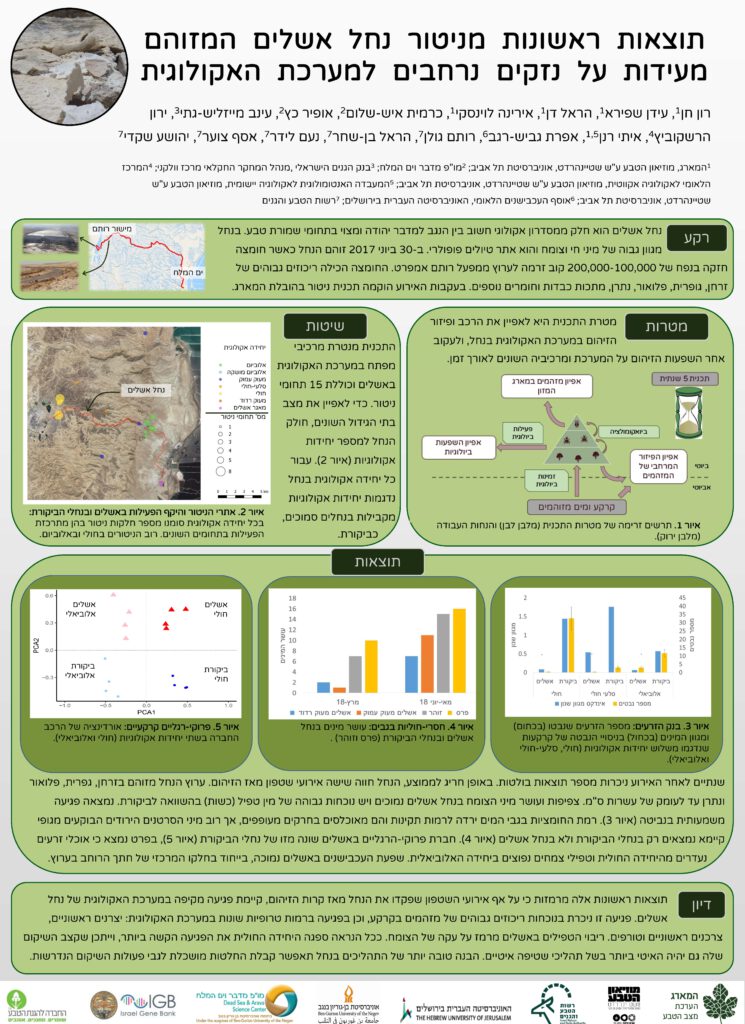In the pollution incident that occurred in the Ashalim stream, hundreds of thousands of cubic meters of acidic waste washed through the stream. The waste originated in an ICL-Rotem company storage reservoir, and contained gypsum, phosphorus, fluorine and various heavy metals. The incident caused the death of many animals and plants, and caused severe pollution of the soil and water, creating a public outcry in Israel. The Ashalim stream, located in the heart of the Judean Desert Nature Reserve, was rich in both animals and vegetation, and was considered a popular route among hikers. The intensity and anomalous nature of the pollution incident led Israel’s Nature and Park Authority to establish a multi-annual monitoring program headed by Hamaarag. The pollution event is unique on a global level, as no similar case of the polluting of a desert stream with such high volumes of acid had previously been recorded.
The monitoring program in Ashalim stream was established in 2018 to monitor the effect of pollution on the stream’s ecosystems. Fifteen research groups from seven research institutions, specializing in different subjects, are taking part in the monitoring program.
Key findings
The coordinator of the monitoring program in Hamaarag described the key findings: “The monitoring results have shown that there is wide-ranging and ongoing damage to the ecosystem of the Ashalim stream. This damage is evident in both biotic and a-biotic components of the ecosystem, and in the different trophic levels – producers, consumers and predators. The damage to the sandy area located upstream was found to be the most significant, and high concentrations of pollutants were found in the soil in that area. In addition, we found that heavy metals, originating from the pollution incident, accumulated in both plant and animal tissues.
On the other hand, the program coordinator expanded – “certain components of the stream exhibit signs of recovery, due to – among other reasons – an unusual number of rain events and strong floods that impacted the many water pools located in the rocky area of the stream”. This helped the gradual restoration of the invertebrate community that populates the water pools: three years after the pollution incident, lesser crustaceans were found back in the pools, after they were completely absent in earlier surveys. In contrast, the rain events had almost no impact on the sandy area and on the terraces on the banks of the stream, which were damaged by the pollution and still contain high levels of pollutants three years after the event. It was found that the pollution severely affected the soil crusts and bacterial populations, leading, in particular, to the disappearance of the group of bacteria which provides sources of nitrogen to plants.
One significant result indicating the severe effects of the pollution is the damage to the Ashalim stream vegetation – in the incident itself almost half of the shrubs died. During the monitoring efforts in the years following the event it was found that the seed bank in the soil, as well as the richness of plant species in the stream, were relatively low, compared to findings from the control streams, but that the Ashalim stream itself is slowly recovering.
The results of the arthropod monitoring add an important component to the understanding of the impact of the pollution on the stream – seed-eating ants almost completely disappeared from the sandy area, a fact which indicates damage to the plants’ seed bank. In the alluvial area, downstream, a large number of sap-sucking insects, known to be harmful to plants, was observed in the year following the pollution incident, but already one year later their number decreased and returned to normal, compared to the control sites. This is further evidence of the stressed condition of the plants following the incident, as well as evidence of the recovery process in the alluvial area, compared to the sandy area.
What are the plans for the future?
The monitoring program currently focuses on characterizing and understanding the processes in which pollutants accumulate in the food web, and examines whether damage to the populations’ resilience in the long-run is to be expected. Continuing the monitoring and research efforts in the Ashalim stream in the coming years will promote deeper understanding of the damage to the ecosystem, and lead to more informed decision-making regarding the stream’s restoration.






